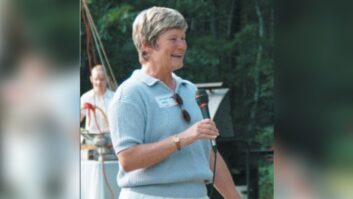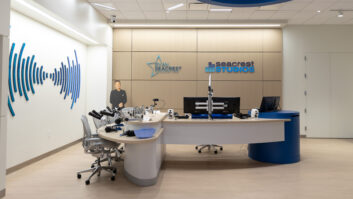ORLANDO, Fla. — “You want to do a remote from where?”
These were the first words out of my mouth when one of our stations came to me with a promotion for a new client. I had never been out of the country, and getting ISDN lines are expensive enough here in Florida. So when one of our top stations asked about doing several days of broadcasts from Amsterdam last fall, the only answer was to do it over IP.

The beneficiaries of Mike Sprysenski’s work in Amsterdam — Jayde, Brian and Johnny Magic of the ‘XL Morning Show’ at a hotel remote with the Comrex Access codec. Fortunately we had gotten a Comrex Access the year before because I wanted to try to eliminate the high cost of ISDN lines if broadband was available. It seemed that when we asked clients if they had a dedicated POTS or ISDN line the standard response was, “We have a DSL line, will that work?”
Double-duty
The Comrex Access is available in two configurations, a portable and rackmount version. It can also double as a POTS codec. Setup is pretty easy on the portable unit using the built-in screen. The portable comes with Wi-Fi and modem PCMCIA cards. It is important to insert the card you want to use in the side PCMCIA slot or USB port before powering it up.
Depending on the type of connection you use (RJ-45 Ethernet, Wi-Fi, POTS or 3G), you configure the parameters needed under the network tab. Then you set up the remote connection by supplying the appropriate IP address or phone number back at the studio along with the codec parameters. You can name and save the connections for future use.
For the rackmount unit it is best to hook up a VGA monitor, keyboard and mouse the first time you configure it, then you can do future configurations using a Web browser. Updates are also easy via a program that comes with the firmware updates. Updates are free and can be downloaded off the Comrex website.
The Access units come standard with various mono and stereo codecs, which sound great. For those that want more, you can buy the AAC encoding option ($425). All of the Access units can receive (decode) AAC connections at no extra charge.
Connections in and out of the rack unit are standard balanced analog or AES XLR connectors. On the portable unit you have a choice of a mono balanced XLR input or 1/8-inch TRS unbalanced line in and out connectors. There is also a 1/8-inch stereo headphone output. You can configure the line output to be either the send audio, receive audio or combination of both.
Normally we leave the line out configured for the IFB audio coming from the studio so we can mix it into the headphones with the local audio at the remote site.
If you really want to have a full remote kit setup in one small package, you can buy the optional mixer for the portable Access. This gives you a five-channel mic or line mixer with headphone amps in one unit that attaches to the side of the portable Access.
Just make sure to have a few batteries charged if you are going to be “off the grid.” The side mixer does use up the batteries about three times faster as not having the mixer attached. The batteries are standard lithium camcorder batteries. My experience so far has been one battery will last about 3 to 4 hours if you just are using the portable Access main unit. If you add the side mixer and three to four headsets, a battery will last about 75 minutes, give or take. I have three batteries that I charge up before each remote where we will not have access to electricity at the site.
At the bar
(click thumbnail)
So what happened in Amsterdam?
To make a long story short we did two days of broadcasts, one on late Saturday afternoon and one on Sunday night (Amsterdam is six hours ahead of Orlando). Each broadcast lasted about 4.5 hours.
The morning show did their special two-hour show each day, then other jocks prerecorded their weekend shifts. The first day we set up on a sidewalk outside of a restaurant about a mile from the hotel where we were staying and used an open Wi-Fi connection that we’d stumbled upon. The second day we set up in the hotel bar because it was raining and 45 degrees outside.
Both days we did the entire broadcasts using battery-powered equipment. Fortunately the battery chargers for the equipment I brought would work using 220V outlets, I just needed to have the appropriate adapters for the sockets used in Europe.
I was very happy with the performance of the Comrex Access equipment. The cost of these units is about that of a typical ISDN box. We use a rackmounted unit to send audio from one of our talk stations to XM Radio. We also have rackmount units set up as backup STL paths to some of our transmitter sites. Using it over the RJ-45 Ethernet connections seems to be solid.
Wi-Fi is more susceptible to interference than a hardwired connection but works fine with a strong signal. If you have a choice always go with a hardwired connection. The use of 3G will depend on your cell coverage. We have had good and bad experiences but that is a wireless carrier issue (and you know how that works).
If Comrex would add ISDN capability to the Access I could see just having the one box in our remote arsenal, but we are already seeing ISDN slowly fade away as broadband connections become easily available, and no doubt using an existing broadband connection out in the field will be more cost-effective in the long run than traditional ISDN lines. And if you can swing a 3G card with a carrier that provides reliable service, doing a remote from anywhere becomes a reality.
Mike Sprysenski is director of engineering with Clear Channel Radio Orlando.
For information, contact Chris Crump at Comrex in Massachusetts at (978) 784-1776 or visitwww.comrex.com.












